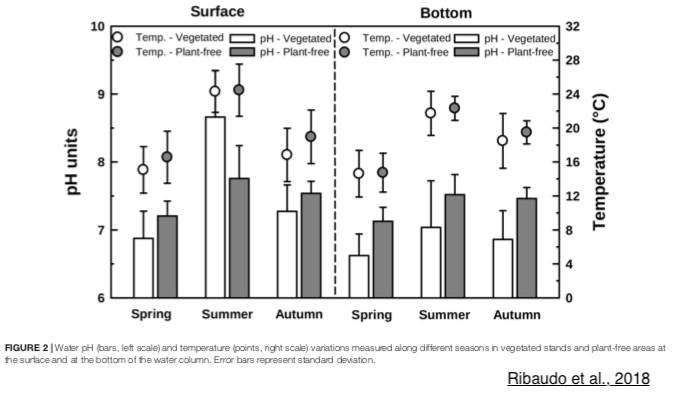AquaVIT
|
Article scientifique C. Ribaudo, J. Tison-Rosebery, D. Buquet, G. Jan, A. Jamoneau, G. Abril, P. Anschutz and V. Bertrin Invasive Aquatic Plants as Ecosystem Engineers in an Oligo-Mesotrophic Shallow Lake Frontiers in Plant Science, 2018, 9, 1781. Exotic hydrophytes are often considered as aquatic weeds, especially when forming dense mats on an originally poorly colonized environment. While management efforts and research are focused on the control and on the impacts of aquatic weeds on biodiversity, their influence on shallow lakes’ biogeochemical cycles is still unwell explored. The aim of the present study is to understand whether invasive aquatic plants may affect the biogeochemistry of shallow lakes and act as ecosystem engineers. We performed a multi-year investigation (2013–2015) of dissolved biogeochemical parameters in an oligo-mesotrophic shallow lake of south-west of France (Lacanau Lake), where wind-sheltered bays are colonized by dense mats of exotic Egeria densa Planch. and Lagarosiphon major (Ridl.) Moss. We collected seasonal samples at densely vegetated and plant-free areas, in order to extrapolate and quantify the role of the presence of invasive plants on the biogeochemistry, at the macrophyte stand scale and at the lake scale. Results revealed that elevated plant biomass triggers oxygen (O2), dissolved inorganic carbon (DIC) and nitrogen (DIN) stratification, with hypoxia events frequently occurring at the bottom of the water column. Within plants bed, elevated respiration rates generated important amounts of carbon dioxide (CO2), methane (CH4) and ammonium (NH4+). The balance between benthic nutrients regeneration and fixation into biomass results strictly connected to the seasonal lifecycle of the plants. Indeed, during summer, DIC and DIN regenerated from the sediment are quickly fixed into plant biomass and sustain elevated growth rates. On the opposite, in spring and autumn, bacterial and plant respiration overcome nutrients fixation, resulting in an excess of nutrients in the water and in the increase of carbon emission toward the atmosphere. Our study suggests that aquatic weeds may perform as ecosystem engineers, by negatively affecting local oxygenation and by stimulating nutrients regeneration.Keywords: carbon emission, methane, hypoxia, water stratification, nutrients regeneration, seasonal, primary production, exotic plants A retrouver ici : https://www.frontiersin.org/articles/10.3389/fpls.2018.01781/full  |